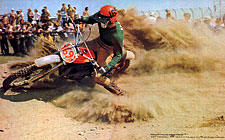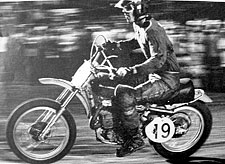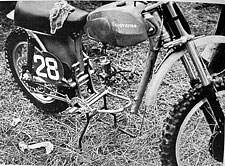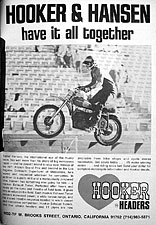Husky Hooker Headers Mystery
by Robert Haag #74Y

I rode Huskys for a few years in the early '70's and got a lot of help with bikes and parts, and a little training with Rolf Tibblin. Husky West also gave me the opportunity of a lifetime and let me tag along with the Team on the summer Inner Am series in '72 though I was only 15 and could only ride a few Sat support races.
Happened to see an add for Hooker Headers expansion chambers from '72 in Cycle Guide as I was going through a box of old magazines, and I finally resolved a puzzle over 35 years old now.
To lay the groundwork, my dad Dave was really into the racing and a great supporter with no pressure but a lot of enthusiasm. He was involved in an accessories company called Pacer, making hop up accessories for early Yamaha Dt'1s, At'1s, and Ct'1s. Also involved were the Jones Family as they were developing the YZ prototypes. I was just a shy quiet squid and couldn't really appreciate Gary's work ethic and speed, as no one could have lived up to the European heroes of the time, but I loved hanging around Don, Gary and Dewayne with all their tall tailed bench racing stories and down home sense of humor. It was really a gift knowing the Jones and through them we met a lot of influential people in the exploding MX scene. A friend of the Jones, Gary Bryson was involved in Pacer and introduced us to the legend ‘50’s Dirt tracker Everett Brashear who was running Husky West, and was instrumental in my later getting Husky's support.
 We also had gotten to know Donny Emler who was working for EC Birt at Precision Cycle in Torrance, before Don started the Flying Machine Factory (FMF was named after his favorite movie Those Magnificent Men And Their Flying Machines). Speaking of squids, Don was a cozy longhaired kid, sleeping on our couch for a few months. He was even a later sleeper than me and I still wonder where he found the work ethic to take FMF so far, many years later. We had Don modify my first expert class bike, an American Eagle with a Zundapp motor 125, including porting, milling the head, jetting the larger Bing, and modifying a Suzuki Pipe. Later he did my brand new '72 New Generation 250, the first Husky I rode. We added a Hooker Header pipe, as they were right down the street from Pacer in Ontario, Ca. That bike was fast and smooth with a broad power band and good top end. We also had gotten to know Donny Emler who was working for EC Birt at Precision Cycle in Torrance, before Don started the Flying Machine Factory (FMF was named after his favorite movie Those Magnificent Men And Their Flying Machines). Speaking of squids, Don was a cozy longhaired kid, sleeping on our couch for a few months. He was even a later sleeper than me and I still wonder where he found the work ethic to take FMF so far, many years later. We had Don modify my first expert class bike, an American Eagle with a Zundapp motor 125, including porting, milling the head, jetting the larger Bing, and modifying a Suzuki Pipe. Later he did my brand new '72 New Generation 250, the first Husky I rode. We added a Hooker Header pipe, as they were right down the street from Pacer in Ontario, Ca. That bike was fast and smooth with a broad power band and good top end.
So as a shy and quiet, laid back So Cal kid, who only really woke up around motorcycles, they arranged it that I got to travel with the Husky team for the summer Inner Am series in '72! Arne Kring, Torleif Hanson, Gunnar Lindstrom, Bob Grossi, Gary Semics, Bill Clements, and Jim West were the Husky riders for the series. Kenth Ohlin was along as the main mechanic, with Clement's buddy JoJo and I helping out too. Later in the series as it moved back East, Dick Burleson who was working at the Ohio distributor played a big part too.
 The first race in Boise Idaho, on a very demanding and steep hilled sand track, was ridden on all new, just uncrated, box stock, big case, New Generation, 250's. I don't think they'd even been started or broken in. It was both inspiring and heartbreaking too, to see them wearing themselves out against the factory Yamahas of Torsten Hallman, Hakan Anderson, Arne Lindfors, the Jones, Jimmy Weinert, and the prototype KX of Brad Lackey, but they still did OK. Up until recent seasons, they'd been able to win on stock bikes, but as we all know, the times were changing so fast. The first race in Boise Idaho, on a very demanding and steep hilled sand track, was ridden on all new, just uncrated, box stock, big case, New Generation, 250's. I don't think they'd even been started or broken in. It was both inspiring and heartbreaking too, to see them wearing themselves out against the factory Yamahas of Torsten Hallman, Hakan Anderson, Arne Lindfors, the Jones, Jimmy Weinert, and the prototype KX of Brad Lackey, but they still did OK. Up until recent seasons, they'd been able to win on stock bikes, but as we all know, the times were changing so fast.
The second race in Washington was not much different, though Torleif seemed inspired and got 2nd I think. It was hot and he looked red enough to faint after the motos. But for the 3rd race, the first ever stadium race in the LA Coliseum, they were really motivated to get the bikes competitive. So this is where the mystery really begins.
 I had ridden the first Saturday support race at Boise, and after hearing how fast my bike was from Kenth Ohlin, who generously had taken me to the race, Torleif came out to my 2nd race at Washington, Spokane I think, to watch and check it out. After my race, he rode my bike and raved about how it ran. So Everett Brashear called my Dad and they set it up to get Emler, still sleeping on the couch, with my brother Steve's help, to port 6 new cylinders in the week just before and in time for the Superbowl (don't we all know the perils of major mods the week before a big important race). They were also getting the heads milled, and Kenth would be building the pipes from stamped pieces Hooker had supplied. I don't know why the pipes came only as parts. I believe mine came already built. I guess they were in early production, as I think Hookers were the first ever stamped accessory pipes made. They also put on the small, but still steel 125 tanks that had been specially painted red, mounted those cool gray vacu-formed early Hallman plastic fenders, and everyone was excited and hopeful that now they'd be competitive. I had ridden the first Saturday support race at Boise, and after hearing how fast my bike was from Kenth Ohlin, who generously had taken me to the race, Torleif came out to my 2nd race at Washington, Spokane I think, to watch and check it out. After my race, he rode my bike and raved about how it ran. So Everett Brashear called my Dad and they set it up to get Emler, still sleeping on the couch, with my brother Steve's help, to port 6 new cylinders in the week just before and in time for the Superbowl (don't we all know the perils of major mods the week before a big important race). They were also getting the heads milled, and Kenth would be building the pipes from stamped pieces Hooker had supplied. I don't know why the pipes came only as parts. I believe mine came already built. I guess they were in early production, as I think Hookers were the first ever stamped accessory pipes made. They also put on the small, but still steel 125 tanks that had been specially painted red, mounted those cool gray vacu-formed early Hallman plastic fenders, and everyone was excited and hopeful that now they'd be competitive.
With a hell of a lot of work and scrambling in one week, all the bikes were ready. They looked great and pretty trick before practice. Unfortunately they had had no time to test the bikes. Again I don't think they had even been started! Hard to imagine by today's standards. No testing and no practice during the weeks between races. A lot of fun traveling, and swimming back at the motels though, as Torleif was known to be wild and crazy in his early 20's.
Getting to, set up at, and looking around at the first ever Superbowl definitely lived up to all the hype, and everyone had high expectations. Frustratingly though, after only a few laps of practice all the guys came in one by one and complained that the bikes were really pipey screamers. It was too late to change anything, so they were sent back out and just had to try to get used to them, give it their best, and see what they could do.
As the night sensationally went on, Torleif who said he liked pipey bikes, got great starts and would have beaten Marty Tripes for the win, if his still stock Girling shock had not broken and come apart in the 3rd moto (remember the good old days of 3 motos). The rest of Team Husky did pretty crappy as I remember and were very frustrated with the motor mods and results.
 They never did have, or take the time to figure out why the bikes were so peaky. The American guys went back to mostly stock engines, and Torleif's works prototype small case Mag arrived from Sweden for the last 3 of the 6 races (yes he did let me ride it at the Pentons practice track in Ohio!). They started experimenting with Eyevind Boyeson's reed cylinders, and I don't know where those early Emler cylinders ended up. I later heard they took one back to Sweden for testing but never got it running right. They theorized the European air was different which sounded like a bunch of hooey to me. They never did have, or take the time to figure out why the bikes were so peaky. The American guys went back to mostly stock engines, and Torleif's works prototype small case Mag arrived from Sweden for the last 3 of the 6 races (yes he did let me ride it at the Pentons practice track in Ohio!). They started experimenting with Eyevind Boyeson's reed cylinders, and I don't know where those early Emler cylinders ended up. I later heard they took one back to Sweden for testing but never got it running right. They theorized the European air was different which sounded like a bunch of hooey to me.
This little known mystery was resolved only recently by seeing the ad for Hooker Headers in the old magazine. While looking closely at Torleif and his bike, and of course nostalgically imagining all the what-ifs, I noticed that the pipe was obviously a 125 pipe!
After that '72 Inner Am series, I got more into riding the 125s, even getting 3rd at the first ever 125 National at Hangtown in '74. So I got to know the early 125 Huskys pretty well. And I'm absolutely sure that's a 125 Hooker Header exhaust on Torleif's 250 in practice at the LA Coliseum. It's much shorter with smaller cones, headpipe, and silencer. A 125 pipe on a 250 has got to be unimaginably pipey to race on an MX track!
It dumbfounds me that the then European Gods of motocross were so unprepared, naive, and unobservant. Not sure what the point of this story is, as the rest is history. Those sure were fun and exciting times though, and hard to ever live up to. The Swedish Husky Team turned out not to be the adolescent's idealized image of perfection after all, but they sure did know how to have fun and I'll be forever grateful and indebted. Just wish I could go back and point out they had the wrong pipes in time for the now astronomically historical and pivotal 1972 Los Angeles Memorial Superbowl Of Moto Cross. Who knows, maybe Stewart or Reed would be riding a Husqvarna today.
Robert Haag #74Y
***
|